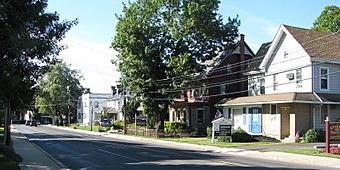Chalfont Historic District facts for kids
Quick facts for kids |
|
|
Chalfont Historic District
|
|

Main Street in Chalfont
|
|
| Location | Roughly bounded by Chestnut Street Park Avenue, Main Street, Butler Avenue and Sunset Avenue, Chalfont, Pennsylvania |
|---|---|
| Built | 1856 |
| Architect | Martin, A Oscar, |
| Architectural style | Gothic Revival, Classical Revival |
| NRHP reference No. | 06001148 |
| Added to NRHP | December 18, 2006 |
The Chalfont Historic District is a special area in Chalfont, Pennsylvania. It's like a protected neighborhood where old buildings and places are kept safe. This district is found in Bucks County, Pennsylvania.
Contents
What Makes Chalfont Historic?
This historic district includes parts of Main Street and Butler Avenue. These streets are home to many beautiful old houses. They show off different styles from the past. You can see homes built in the American Colonial style. There are also houses with Victorian-style designs.
How Big is the Historic District?
The Chalfont Historic District is quite large. It includes 121 buildings that are important to history. There is also one special historic site within the district. These buildings and sites help tell the story of Chalfont.
What Old Buildings Can You See?
Some of the oldest buildings are very interesting. One example is the Simon Butler Mill House. It was built a very long time ago, in 1730! Another important building is the old Chalfont train station. These places help us imagine what life was like in the past.
Why is it a "Historic District"?
A historic district is a group of buildings. They are important because of their history or special architecture. Protecting them helps keep their story alive. It also helps people learn about the past.
When Was it Recognized?
The Chalfont Historic District was officially added to the National Register of Historic Places in 2006. This is a list of places in the United States. These places are considered important to our country's history. Being on this list helps protect them for future generations.



